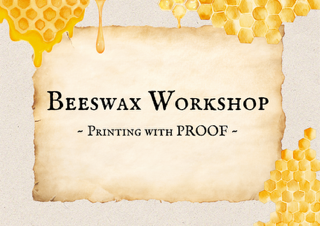
Sustainable Artistry: The Making Of Beeswax Stamps
The Mid-Atlantic Regional Center for the Humanities introduced its new printmakers space, Proof, this past September and has already offered a variety of different workshops. Their next workshop will be on Monday, November 11th, from 11:20 to 12:20, otherwise known as the free period. This workshop explores traditional ancient Roman printing techniques with beeswax and its sustainable nature. It will cover a brief history lecture on the subject and then allow participants to make their very own beeswax stamps which they can take home.
History of Beeswax Tablets:
The Romans were the first to invent the concept of apiaries: a farmable collection of beehouses. The word stems from the classical Latin word “apis”, which meant bees, and eventually tumbled through time to become what we know as “apiaries” or “apiariums.” Yet, the Romans didn’t organize these collections of beehives to simply satisfy their sweet tooth. While honey had a variety of purposes, such as in cooking, distilling, or medicine, the Romans utilized every bee-byproduct. This included beeswax.
Romans would harvest this wax to create sculptures, use it as glue in architecture, and even for medicinal purposes. But its most popular use was for writing. Beeswax tablets were commonly used in place of papyrus or any other paper alternative. This was done for many different reasons. Papyrus paper was limited and usually only accessible to the elite unless you made your own. Other than the occasional letter, most plebeians, Roman commoners, had no use for writing. Many wouldn’t even know how. Therefore, papyrus paper was reserved for “important” matters, such as recording laws, historical events, court happenings, and even the occasional story. Beeswax tablets were therefore used in place of those permanent records and were used on a more day-to-day basis. If we are comparing modern day, you would use papyrus paper for your tax returns and beeswax tablets for your grocery list.
How Beeswax Tablets Were Made:
After harvesting beeswax, it would be melted down until it was in liquid form. This liquid was often referred to as liquid gold due to its golden color and its diverse uses. After it is melted, it would be poured into a container of some kind. These were usually thin wooden frames with a lip around the edge to hold the liquid in place as it dried. Then you needed a stylus. Styluses were often long wooden or metal sticks with a thin, sharp end. Styluses were more of a carving tool than a writing tool when it came to beeswax. When the beeswax was dried in its container, you simply used the stylus to carve a relief of your drawing or text.
Beeswax wasn’t used for its accessibility and abundance, however. It was used because of its forgiving nature. Beeswax can be used, melted down, and repoured a seemingly unlimited amount. The only sacrifice one makes when remelting beeswax is its sweet, honey scented smell. Because beeswax is sensitive to heat, you can easily correct a mistake in a drawing or a text by warming it with your finger and smoothing it out again. Its lack of permanency was considered a benefit for its practical uses.
Beeswax Stamps: Workshop Demonstration
While beeswax tablets are usually the size of printer paper, Proof’s guided activity will work on a much smaller scale. Participants will follow the traditional procedures for making a wax tablet, but instead will carve a stamp design of their choosing. They will then use inks to transfer their design onto paper. This stamp can be used time and time again, or melted into a new design.
These workshops are an interactive, yet educational way to teach the importance of sustainability in the printing world and the creative possibilities it bears. Proof’s objective is to educate students and workshop attendees in an engaging, hands-on way while also providing a break from traditional everyday studies. Join Proof in its next workshop on November 11th and make your very own Roman stamp.
